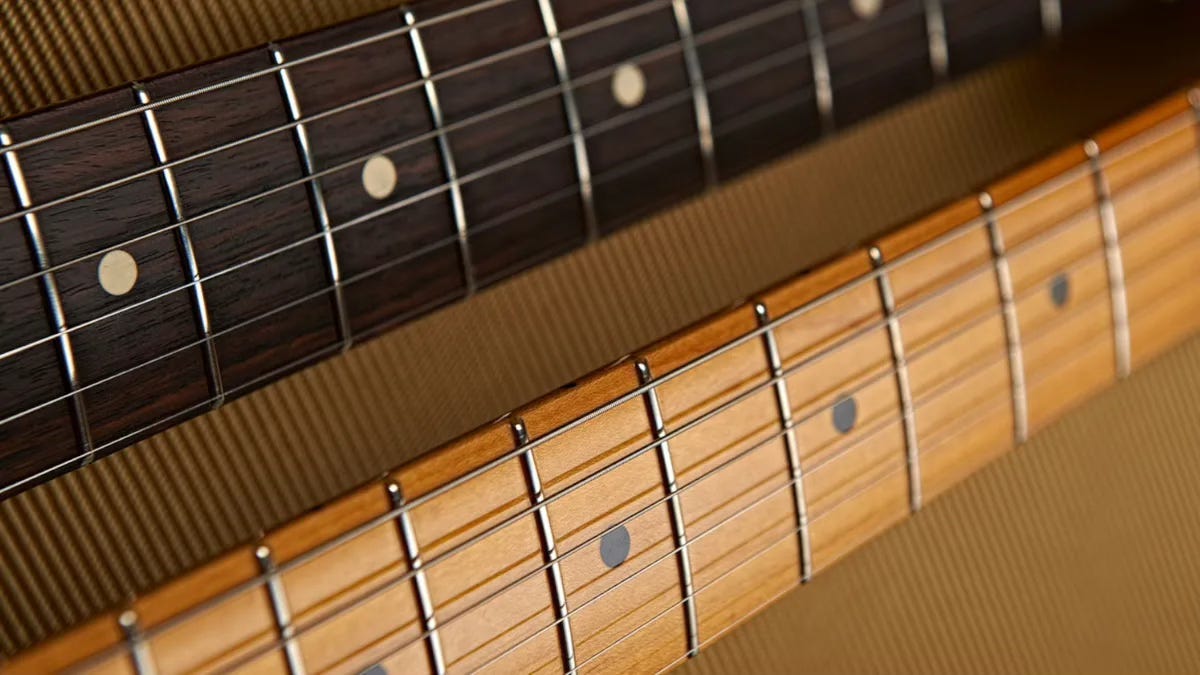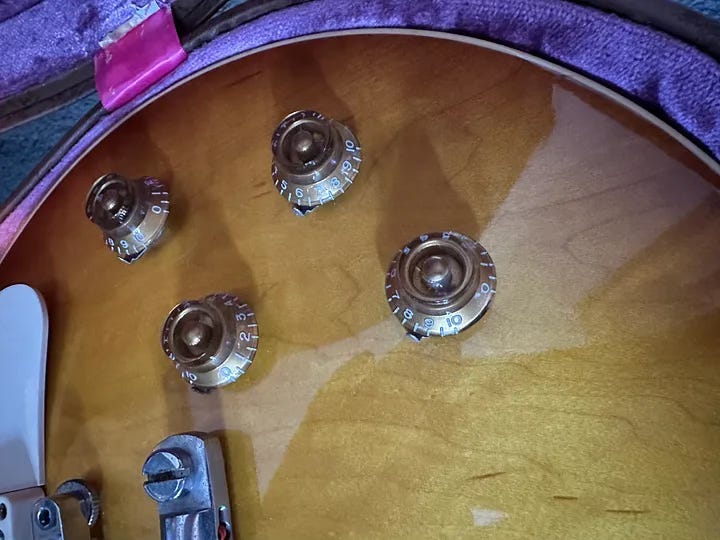Howdy, Stranger!
It looks like you're new here. If you want to get involved, click one of these buttons!
Categories
- 245.2K All Categories
- 22 >> Start Here <<
- 12 New Members
- 8 FAQs
- 87.9K Gear
- 40K Guitar
- 3.5K Acoustics
- 1.3K Bass
- 14.9K Amps
- 17.4K FX
- 317 Digital & Modelling
- 776 Other Instruments
- 8.4K Making & Modding
- 427 Gear Reviews
- 107 Guitar Reviews
- 74 Amp Reviews
- 119 FX Reviews
- 87 Other Reviews
- 752 Made in the UK
- 978 Theory
- 1.9K Technique
- 2.2K Live
- 3.2K Studio & Recording
- 2.2K Making Music
- 227 Events
- 15 Guitar Show 2018
- 851 Plug My Stuff
- 106.8K Classifieds
- 41.8K Guitars £
- 2.9K Acoustics £
- 143 LH Guitars £
- 916 Basses £
- 10.8K Parts £
- 18.6K Amps £
- 34.6K FX £
- 2.9K Studio & Rec £
- 6.2K Misc £
- 466 Personnel
- 55.5K Chat
- 37.1K Off Topic
- 1.1K Tributes
- 6.7K Music
In this Discussion
Become a Subscriber!
Subscribe to our Patreon, and get image uploads with no ads on the site!
Fender Stratocaster vs Gibson Les Paul: An in-depth comparison
Before we go any further, I want to make it clear that the comparison is between Gibson and Fender models, not the incalculable copies that are on the market — although they’re generally very similar, I can’t for certain say that the wood selections will be identical or the wiring will be the same.
Also, this comparison is between their standard models, it isn’t about going into the minutiae for every version the companies ever released.
The woods used in a Strat and Les Paul
Fender Stratocasters most typically are built with either alder or ash for the body — Fender has written more about this here.
The Gibson Les Paul has a mahogany body, and often a maple cap glued on top of that.
The Les Paul has a mahogany neck and headstock, with a rosewood fretboard. The Strat usually has a maple neck with either a maple or rosewood fretboard.

Scale length
Scale length is the distance between a guitar’s nut and bridge. A Gibson Les Paul has a 24.75” scale length. A Fender Stratocaster has a 25.5” scale length. The longer scale length has some extra tension, which means strings feel a little heavier, so you’ll notice some resistance when trying to bend strings compared to a guitar with a shorter scale length. It’s not uncommon for players to use slightly lighter strings on a Fender — for example if a player uses 10s on a Les Paul, they may use 9 or 9.5 gauge on a Stratocaster.
But the extra tension also contributes to the famous bright snappiness of the Strat. In comparison, the Les Paul has a warmer, more ‘rounded’ sound, and string bends are comparatively much easier.
Lastly, the frets. If there’s more distance between the nut and bridge, the fretboard needs to be longer. The only way to do that is by increasing the size of the frets.
Which is heavier: Strat or Les Paul?
Les Pauls have developed a reputation over the years of being heavy — sometimes even too heavy. While there’s some truth to it, it’s not universal.
In the past, the prevailing wisdom has been that a heavier guitar has better tone and better sustain. In the 1970s specifically, Gibson was releasing very heavy models, of 10, 11, 12lbs or even more.
These days, a typical Les Paul Standard is usually around 9lbs, but this can vary.
Fender Stratocasters typically weigh around 8lbs, some lighter and some heavier. On paper, a difference of 1 or 2lbs doesn’t sound like much — but it can make a remarkable difference to how they feel on the shoulder, so always try to play a guitar standing up before you purchase it.
Finishes on Strats and Les Pauls
All Gibson-branded guitars have a nitro finish.
Fender mostly use poly today, but you can find nitro on its more expensive models, including the Custom Shop.
Critics will say poly feels like plastic. Advocates praise its consistency and it being hard wearing.
Nitro critics will say it gets brittle and cracks over time. Advocates love these things as it gives the guitar character as it ages, and say it feels nicer to play.
It’s a “your mileage may vary” topic. Personally I own guitars with both, and have no complaints.
Configuration of knobs and pickups
The volume knob is a master volume, meaning it controls all 3 pickups. The first tone knob controls the neck pickup only. The second tone knob controls the middle pickup only, and the bridge pickup doesn’t have a tone control. The 5-way selector switch allows you to select each pickup individually, or neck/middle, or middle/bridge.

Things work differently on the Les Paul. There are usually two pickups, and each one has a master volume and master tone control, allowing you to get full control over the range of each pickup.
For example, because there isn’t a master volume that controls all the pickups at once, a Les Paul allows you to have the pickups set at different volumes and use the selector switch to instantly go between them. Players will commonly set one pickup as the rhythm tone and the other for the lead tone, then flick the switch instead of using a boost pedal.
Unlike the Strat’s 5-way switch, the Les Paul has a 3-way switch giving access to each pickup independently and the middle position. The independent tone and volume controls open up a huge range of sounds in the middle position, allowing you to blend anything from pickup being at 10 and the other at practically off, and everything in between.

How do they sound against each other?
This is perhaps the million dollar question. I believe that most guitars can do most things, so you should buy the one that most appeals to you.
That said, the Les Paul is very renowned for its warm, creamy, rich tones while the Strat is renowned for its clarity, attack, and brightness.
With some conscious effort and tweaking your amp EQ you’ll be able to get both to do most of what you want. If you specifically want their signature sounds though, then you probably already know which one is for you.
Conclusion: which is better?
Both guitars have endured for as long as they have for one simple reason: they’re both great. They’ve spawned a million copies and imitators for the same reason.
But there is no “better” or “worse” here — just two extremely iconic, popular, enduring guitar designs that are loved around the world for good reason.
Play both, experiment with the sounds they offer, how they feel in your hands and over your shoulder, and go home with the one that you don’t want to put down.
I had to cut this article to fit the forum's word limits, the full version is on my free guitar-focused Substack
 LOL 0
LOL 0 Wow! 0
Wow! 0 Wisdom
Wisdom Base theme by DesignModo & ported to Powered by Vanilla by Chris Ireland, modified by the "theFB" team.


Comments
I would perhaps add that the Gibson typically has a flatter fretboard, which makes it less likely to choke out on string bends and a bit more suited to slide playing (not always, but for most styles), however, the more curved fretboard on a typical Fender makes barre chords a bit easier to play, so it is perhaps a better beginner guitar, particularly given that a Fender is usually a bit less expensive than a Gibson, which is an attractive point when starting out and having to also find the cash for an amplifier as well.
I have made an accompanying video (I could definitely do it again and cut it down though!), but didn't want to include the link in this article to look too promotional. I did link to my Substack at the end of the post and the video is embedded in there though.